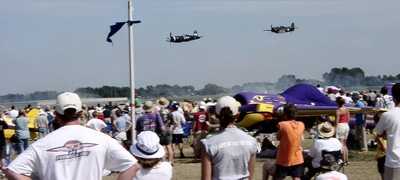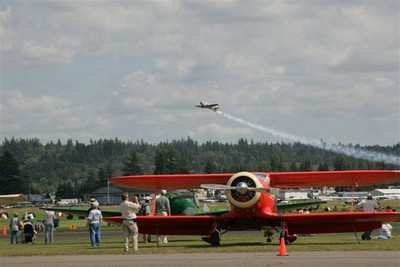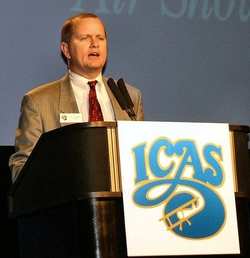ICAS's John Cudahy Responds to CNN Air Show Segment
 E-I-C Note:
The International Council of Air Shows has sent the following
letter to CNN to protest the 'shoddy journalism and
sensationalistic reporting' demonstrated in a September news
segment that aired on that network.
E-I-C Note:
The International Council of Air Shows has sent the following
letter to CNN to protest the 'shoddy journalism and
sensationalistic reporting' demonstrated in a September news
segment that aired on that network.
Dear Mr. Davis:
My name is John Cudahy. I am president of the International
Council of Air Shows, a trade association based in Leesburg,
Virginia that represents air show pilots and air show event
organizers.
I’m addressing this note to you in your capacity as
executive vice president of news standards and practices for CNN.
Specifically, I wanted to pass along my perspective on the air show
story that was broadcast on CNN’s “Out in the
Open” program on September 3. (Incidentally, although there
is a link to the segment on your website, this version has been
heavily edited and does not include much of the material that
originally aired.)
As an industry, we understand that air show accidents are
compelling material for television news programs. There is almost
always dramatic video to illustrate the story. Nationwide, air
shows attract more than 10 million spectators every year, so there
is broad interest in our events among the general population. And
accidents typically occur over the weekend when “hard
news” is a bit more difficult to come by.
But we believe that the occasional availability of dramatic and
sometimes disturbing video footage comes with a responsibility for
news organizations to deal with that footage responsibly, fairly
and accurately. By almost any measure, CNN failed to live up to
that obligation on September 3. In the hope that we can avoid
misunderstandings of this type in the future, I’d like to
summarize what we consider to be several serious problems with the
story and how it developed.

- Several air show pilots received calls from CNN personnel on
the morning of Monday, September 3 asking if the pilots would
consider participating in a live interview to be aired on
“Out in the Open” at approximately 8:30 p.m. EDT that
same night. They were told that the interview would focus on what
those pilots do to train and prepare for their aerobatic
performances. The producers making the phone calls asked good,
specific questions that would have supported this line of
questioning during the interview. Nonetheless, most of the pilots
sensed that things were not as they seemed and declined the
invitation to participate. One of the pilots agreed to be
interviewed that evening. During the live interview, none of the
issues that were discussed in the pre-interview were discussed on
air. Instead, the show’s host rolled accident footage, asked
the pilot to comment on it, and then rolled more accident footage
before the pilot could complete his commentary. The pilot being
interviewed was in a studio that did not have playback
capabilities, so the show’s host (Rick Sanchez) was asking
the pilot questions about accident footage that he could not see.
Understandably, he spent the first half of the interview looking
surprised and confused as a result of this sudden change in subject
matter and his inability to see the footage that he was being asked
about.
- Footage from a 1988 accident involving the Italian military jet
demonstration team at Ramstein Air Force Base in Germany was shown
eight times during a four- or five-minute segment. Though Sanchez
mentioned initially that it was footage from an accident in 1988,
that footage was juxtaposed with more recent footage and repeated
almost non-stop through the middle portion of the interview.
Sanchez commented at least once that, “This is the kind of
thing that can happen at these air shows.” Even a very
attentive viewer would have been left with the impression that
attending an air show is very dangerous for both the pilot and the
audience.

In fact, the opposite is true. Air show flying can be dangerous
and every one of our pilots is fully aware of that risk before they
take off. But no air show spectator has been killed at a North
American air show in more than 55 years. From NASCAR to IRL to
hydroplane races, our safety record is the envy of the entire motor
sports industry. This safety record is a direct result of this
country’s air show safety regulations and our
industry’s cooperative relationship with the FAA on
spectator-related safety issues. We have worked very hard during
the last half-century and with considerable sacrifice to absolutely
safeguard the safety of our audiences. Protecting the audience is a
moral imperative to the people who work in our business and a point
of considerable pride in our industry. But CNN’s story
suggested the opposite to your viewers. The juxtaposition of the
Ramstein footage with the footage from more recent accidents
suggested that air shows are dangerous to spectators. Demonstrably,
quantifiably, and historically, this is simply not true.
CNN is under no obligation to promote or support the U.S. air
show industry.

Nonetheless, it would seem to us that the real is story is that
U.S. audiences have been so well protected during the last 50+
years. Indeed, just three months before that 1988 accident in
Germany, that same Italian team was flying in the United States.
They were prohibited from performing the maneuver that they were
flying when they had the accident in Germany because the FAA deemed
it to be unsafe. More recently, the air show community has suffered
through four different, highly publicized accidents. In every
single case, our system worked as designed and nobody in the
audience was hurt. In any case, there is absolutely nothing about
these recent accidents that should have prompted CNN to terrify the
American public into believing that their well-being was a risk if
they were silly enough to get anywhere near an air show. When it
comes to spectators, our safety record is impeccable.
 Mr. Davis, the public
was not well served by this segment. At the very least, the
producers and host of this segment did not do their homework and
failed to understand the true nature and risk of air show accidents
in the United States before airing a segment that suggested very
strongly that air shows are dangerous to the spectators who attend
them. Information on air show safety and accident history is very
easy to come by. Indeed, just this spring, Miles O’Brien
developed a CNN segment that accurately and fairly describes air
shows, the risks that they present to pilots and the risks that
they DO NOT present to the audience. The truth is not as exciting,
sensationalistic or dramatic as this fictional portrayal of the
danger of air shows. But it is the truth.
Mr. Davis, the public
was not well served by this segment. At the very least, the
producers and host of this segment did not do their homework and
failed to understand the true nature and risk of air show accidents
in the United States before airing a segment that suggested very
strongly that air shows are dangerous to the spectators who attend
them. Information on air show safety and accident history is very
easy to come by. Indeed, just this spring, Miles O’Brien
developed a CNN segment that accurately and fairly describes air
shows, the risks that they present to pilots and the risks that
they DO NOT present to the audience. The truth is not as exciting,
sensationalistic or dramatic as this fictional portrayal of the
danger of air shows. But it is the truth.
But worse than the inaccuracies and missed opportunities is the
nagging perception within our organization and among our members
that this segment was deliberately misleading and alarmist. The
ambush tactics with the interviewee, the repeated use of largely
irrelevant 19 year-old video footage, and the inattention to easily
accessible facts that would have contradicted the central premise
of the segment together suggest a deliberate effort to direct the
story in a specific and inaccurate direction.
We would like to create and maintain a strong relationship with
all of the news media and, in particular, with CNN. And we
recognize that air show accident footage will continue to be
broadcast on CNN and other networks. But we’d like the
accompanying reporting and subsequent analysis to be accurate. If
we deserve criticism, we’re more than willing to take it.
Indeed, we welcome it. But there was no greater purpose served by
that September 3 report. For no reason, the public was left with an
inaccurate and unfair perspective on air show safety. It was very
surprising to see that kind of sensationalistic approach from
CNN.
I am not familiar with the internal review mechanisms used at
CNN. But I would suggest that they be employed now to figure out
what happened. We have come to expect this kind of
“gotcha” journalism from some of your competitors, but
CNN is the gold standard. It should not be participating in this
kind of silliness.
John Cudahy, President
International Council of Air Shows
 ANN's Daily Aero-Linx (05.06.25)
ANN's Daily Aero-Linx (05.06.25) ANN's Daily Aero-Term (05.06.25): Ultrahigh Frequency (UHF)
ANN's Daily Aero-Term (05.06.25): Ultrahigh Frequency (UHF) ANN FAQ: Q&A 101
ANN FAQ: Q&A 101 Classic Aero-TV: Virtual Reality Painting--PPG Leverages Technology for Training
Classic Aero-TV: Virtual Reality Painting--PPG Leverages Technology for Training Airborne 05.02.25: Joby Crewed Milestone, Diamond Club, Canadian Pilot Insurance
Airborne 05.02.25: Joby Crewed Milestone, Diamond Club, Canadian Pilot Insurance







